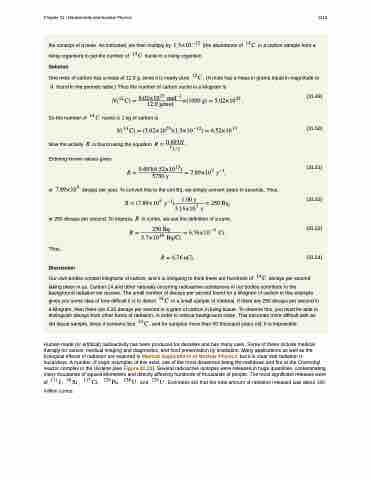Page 1427 - College Physics For AP Courses
P. 1427
Chapter 31 | Radioactivity and Nuclear Physics 1415
the concept of a mole. As indicated, we then multiply by ��������� (the abundance of �� � in a carbon sample from a
living organism) to get the number of �� � nuclei in a living organism.
Solution
One mole of carbon has a mass of 12.0 g, since it is nearly pure �� � . (A mole has a mass in grams equal in magnitude to � found in the periodic table.) Thus the number of carbon nuclei in a kilogram is
���� �� � ��������� ����������� �� � ��������� � ���� �����
So the number of �� � nuclei in 1 kg of carbon is
���� �� � ���������������������� � ����������
Now the activity � is found using the equation � � ������ . ����
Entering known values gives
� � ���������������� � �������� ���� ���� �
or �������� decays per year. To convert this to the unit Bq, we simply convert years to seconds. Thus, � � ��������� ���� ���� �� � ��� ���
� � ��� �� � ��������� ��� �������� �����
Thus,
� � ���� ����
Our own bodies contain kilograms of carbon, and it is intriguing to think there are hundreds of �� � decays per second
taking place in us. Carbon-14 and other naturally occurring radioactive substances in our bodies contribute to the background radiation we receive. The small number of decays per second found for a kilogram of carbon in this example
gives you some idea of how difficult it is to detect �� � in a small sample of material. If there are 250 decays per second in a kilogram, then there are 0.25 decays per second in a gram of carbon in living tissue. To observe this, you must be able to
distinguish decays from other forms of radiation, in order to reduce background noise. This becomes more difficult with an old tissue sample, since it contains less �� � , and for samples more than 50 thousand years old, it is impossible.
������� �
or 250 decays per second. To express � in curies, we use the definition of a curie,
(31.49)
(31.50)
(31.51)
(31.52)
(31.53)
Discussion
(31.54)
Human-made (or artificial) radioactivity has been produced for decades and has many uses. Some of these include medical therapy for cancer, medical imaging and diagnostics, and food preservation by irradiation. Many applications as well as the biological effects of radiation are explored in Medical Applications of Nuclear Physics, but it is clear that radiation is hazardous. A number of tragic examples of this exist, one of the most disastrous being the meltdown and fire at the Chernobyl reactor complex in the Ukraine (see Figure 31.23). Several radioactive isotopes were released in huge quantities, contaminating many thousands of square kilometers and directly affecting hundreds of thousands of people. The most significant releases were
of ��� � , �� �� , ��� �� , ��� �� , ��� � , and ��� � . Estimates are that the total amount of radiation released was about 100 million curies.


